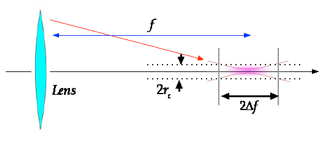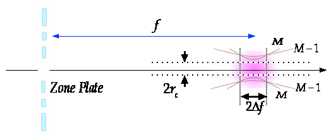Atelier Bonryu(E)
zone plate photography


Atelier Bonryu(E)
zone plate photography



























Focusing of a zone plate: We consider to fit a zone plate to a digital SLR and to take a photograph. Though an image by a zone plate is by far brighter than that by a pinhole, brightness is still low to bring the image into focus by looking at it in a viewfinder of the SLR. Therefore, usually we should calculate a distance from the zone plate to the image screen and adjust the position of the screen.

In the case of a usual camera with a glass lens, the criterion of focusing is defined by using a diameter of a circle of confusion. This diameter is expressed as the length of a diagonal of an image sensor (or a film) divided by a coefficient of around 1500. A depth of focus is defined by the range of the focal length where the diameter of the image of a point source at infinity is less than the diameter of the circle of confusion. Similarly the depth of field is defined by the corresponding range of the distance of a photogenic object from the lens. As a diagonal length of an image sensor of a four-thirds format digital camera which I use is 21.63 mm, the diameter of a circle of confusion of this camera is about 0.015 mm. By the way in the case of a zone plate which is used conventionally for taking photographs the diameter of the image of a point source at infinity is already larger than the diameter of the circle of confusion (e.g., for a zone plate with f = 100 mm, 25 zones, the image radius is about 0.06 mm: *5). Thus, in such a zone plate the depth of focus and the depth of field defined for a conventional camera with a lens are meaningless. Therefore, the depth of focus and the depth of field for a zone plate camera are defined as the ranges of the focal distance and the distance to the object so that the light waves from the outermost zone do not become completely out of phase. It means that the light from the outermost zone does not contribute to make the resolution of the image higher when the position of the image screen or the object is out of the permissible range. Though this definition gives a measure of the resolution of the image projected by a zone plate, it should be remarked that these values cannot be compared directly with those of a camera with a glass lens.



The depth of focus for a point source at infinity (a zone plate) is usually determined from the positions where a radius of an image formed by a zone plate with M zones is equal to that by a zone plate with M-1 zones.


















The depth of focus for an image of an object at finite distance from the camera
The permissible range of location of the image screen for an object at the finite distance from the camera.


Laboratory: Zone Plate Photography
Theory of Zone Plate Photography
- Focusing and Depth of Field -
